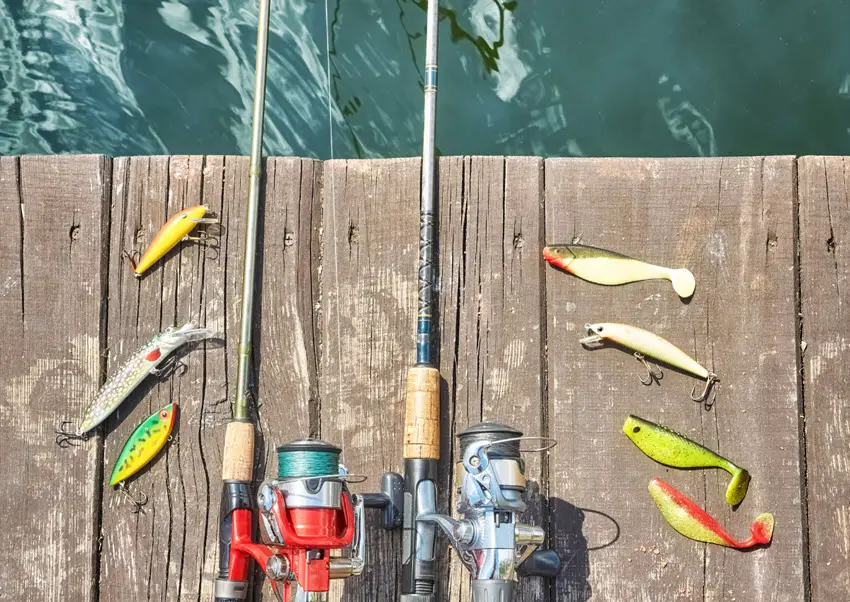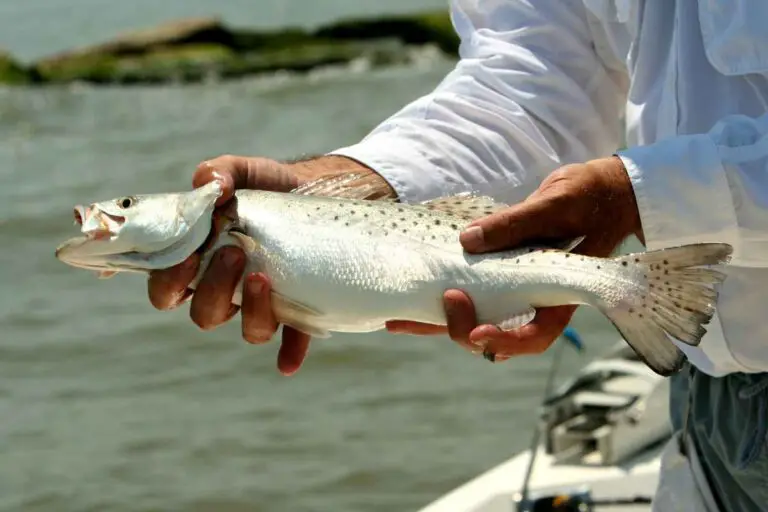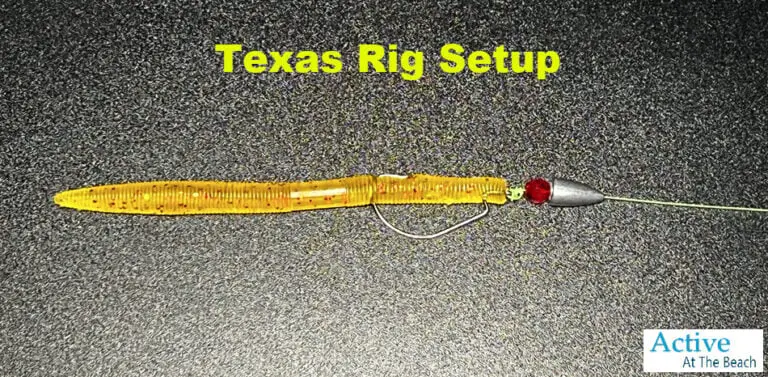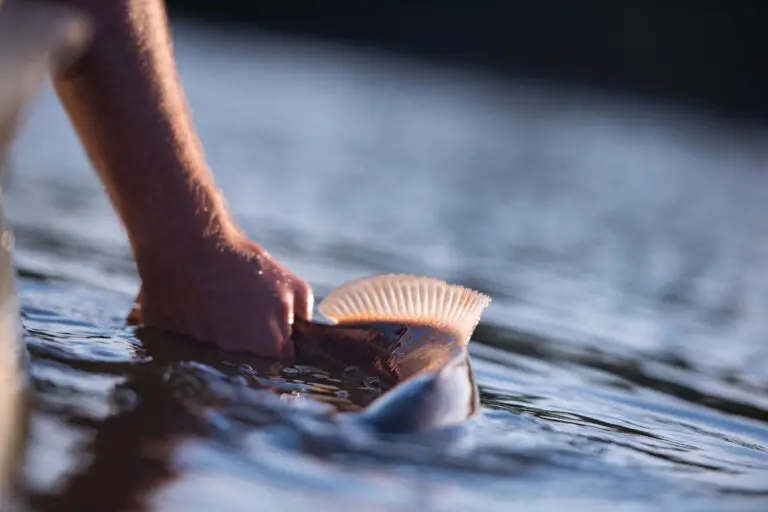The Best Lures for Redfish Fishing: Top 5 Picks for Beginners
Are you new to fishing for redfish and struggling to find the right lure for your next trip? Look no further! This comprehensive guide features the top 5 lures specifically designed for beginners, taking the guesswork out of your fishing experience. With so many options available, it can be overwhelming to choose the right one.
That’s why we’ve compiled this list to help you select the perfect lure for your skill level and fishing conditions. Each of these lures is proven to attract redfish, giving you the best chance of a successful catch.
So, read on to discover the top 5 lures for redfish fishing and take your angling skills to the next level!
Introduction
Redfish are a prized game fish found in many coastal areas of the United States. They are known for their hard fight, stunning appearance, and delicious taste. If you’re looking to catch redfish, choosing the right lures for the job is essential.
We’ll provide detailed descriptions of each lure, including the maker, model, and weight, so you can decide which one to use on your next fishing trip. Whether you’re a seasoned angler or just starting, these lures will surely attract redfish and help you land the catch of a lifetime.
A well-chosen lure can distinguish between a great day on the water and going home empty-handed. In this article, we’ll briefly overview the top 5 lures for beginners and explain why choosing the right lures is crucial for successful redfish fishing.
Lure 1: Soft Plastic Baits
Adaptability Of Soft Plastic Baits For Redfish Fishing
Soft plastic baits can be used in a variety of ways when redfish fishing. They can be rigged on jigheads or weighted hooks, Texas-rigged with various weights, or “Ned Rigged” which is a technique where they’re fished weightless on a small jighead.
These different methods allow anglers to target different depths and areas where redfish congregate without having to switch out lures each time. This makes soft plastic baits an incredibly versatile option when it comes to targeting this species.
Choosing The Right Soft Plastic Bait For Redfish Fishing
When choosing a soft plastic bait for redfish fishing, there are some key factors to consider such as size, color, and action.
A good rule of thumb is that larger baits can be used in deeper water while smaller baits work better in shallow water or around vegetation. Color selection also depends on the water clarity; if it’s murky you may want to opt for brighter colors like chartreuse or pink whereas if it’s clear you may want to go with more natural colors like white or grey.
Lastly, action is important because you want your bait to have an enticing movement underwater so that the redfish will strike at it. In general, paddle tail baits tend to work well since they offer lots of movement when retrieved through the water column.
Tips for Rigging and Presenting Soft Plastic Baits
Rigging soft plastic baits is relatively simple as long as you know what pieces of tackle you need. You’ll want a hook that’s appropriately sized for the bait, and you’ll want to thread the hook through the bait from nose to tail. Once that’s done, you should use a jig head with an eyelet at the nose or tail end of the bait, depending on where you prefer to place your hook. Now, it’s time for presentation!
When presenting soft plastic baits, it’s important to keep in mind that redfish are usually bottom feeders. Therefore, it’s best to cast your line close enough for your bait to reach or hover just above the seafloor. It might take some practice, but once you get used to estimating distance and casting accurately, you’ll be able to find success more quickly with each outing.
Best Conditions And Locations For Using Soft Plastic Baits
When fishing with soft plastic baits, the most important factor is location. Redfish are most commonly found in shallow waters near shorelines and grass beds. These areas provide plenty of food sources like shrimp and baitfish that the redfish feed on. To target these areas, use a short casting rod with a light line of 8-10 lbs test. This will allow you to cast farther with more accuracy to get your lure into tight spots where the redfish may be hiding.
Another important factor when using soft plastics is presentation. Make sure your bait is presented naturally so that it mimics the movements of its prey. You can do this by twitching or jerking your rod tip as you reel in the bait or by employing a slow retrieve technique that allows the bait to move erratically through the water column. Both techniques will entice curious fish looking for an easy meal.
Choosing the right color is also key when using soft plastics. Generally speaking, natural colors like white or gray work well if there is bright sunlight above the water’s surface; however, if there is low light (dusk/dawn) or cloud cover then brighter colors such as chartreuse or pink may be better suited for success. Experiment with different color combinations until you find what works best in your area!
Soft Plastic Baits For Beginner Fishing
If you’re a novice angler looking for the perfect baits to start your redfish fishing adventures, these 3 soft plastic lures are just what you need!
Berkley Gulp! Swimming Mullet
- Maker: Berkley
- Model: Gulp! Swimming Mullet
- Length: 4 inches
- Most popular color: Pearl White/Chartreuse
Z-MAN Scented PaddlerZ 5 Soft Plastic Paddletail
- Maker: Z-Man
- Model: PaddlerZ
- Weight: 1/8 oz (pack of 5)
- Length: 5 inches
- Most popular color: Redbone
H&H TKO Shrimp Lure with Lifelike Action
- Maker: H&H
- Model: TKO Shrimp
- Weight: 1/4 oz (pack of 3)
- Length: 3 inches
- Most popular color: Shrimp
Lure 2: Gold Spoon
What Are Gold Spoons And Why Are They Good For Redfish?
Gold spoons are good for redfish fishing because they are highly reflective and create a lot of flash in the water, which can attract the attention of redfish.
Additionally, gold spoons are versatile and can be used in a variety of conditions, including clear or murky water, and they can be retrieved at different speeds to mimic the movement of various prey species.
Finally, gold spoons are relatively weedless and can be fished in areas with heavy vegetation without getting hung up.
Choosing The Right Spoon For Redfish
When picking out your gold spoon, consider the size of the fish you’re after. Smaller spoons work best for smaller fish, while larger spoons are good for targeting larger species.
You also want to choose a spoon that is slightly heavier than other lures, as this will make it easier for you to cast it farther out.
Casting And Retrieving Techniques For Spoons
When using a gold spoon for redfish, cast it out and retrieve it slowly, allowing it to wobble back and forth in the water. Vary your retrieve speed until you find what works best for your target species.
Remember to match the size of the spoon to the size of the baitfish in the area where you’re fishing. With practice and patience, using a gold spoon can be an effective way to catch redfish!
What Conditions Are Best For Using Gold Spoons?
When it comes to using gold spoons, certain conditions will give you better results than others. Gold spoons tend to work best on sunny days when the light is strong and the water is clear. They may not be as effective on cloudy or overcast days when visibility is lower.
Gold spoons can be used throughout the day, but they tend to work best during low-light periods like dawn and dusk. This is because the reduced light makes it harder for fish to see their prey, so they may be more likely to strike at a shiny lure like a gold spoon.
Gold spoons are particularly effective at catching predatory fish like redfish, trout, and snook. They can also be used to catch other species like bass or panfish, but you may need to vary your retrieval speed and technique to find what works best.
Where Should You Use Gold Spoons?
Gold spoons are best suited for stained or dark water, where the weedless feature excels in areas containing potential snagging hazards such as weeds, mangroves, oyster beds, or rocks
These lures also work well around structures, such as rocks or logs, since they create vibrations that mimic small baitfish which attract larger predators.
Lastly, they’re also an excellent choice in deep water since they can be cast farther than other lures and still attract plenty of attention from curious fish below.
Recommended Gold Spoons For Beginners
Here are three recommended gold spoon options for beginners to consider when fishing for redfish:
Johnson Sprite Spoon
- Maker: Johnson
- Weight: 1/2 oz
- Length: 2.25 inches
- Most popular color: Gold
Acme Kastmaster Hammered Gold Spoon
- Maker: Acme
- Weight: 3/8 oz
- Length: 5.5 inches
- Most popular color: Gold
Berkley Johnson Silver Minnow Gold Spoon
- Maker: Berkley
- Weight: 1/4 oz
- Length: 2 inches
- Most popular color: Gold
Lure 3: Topwater Lures
What Are Topwater Lures?
Any fisherman worth their salt knows that topwater lures are one of the best ways to catch redfish in saltwater. But to be successful, you need to know when and where to use them. Here are some tips on the best conditions and locations for using topwater lures.
Topwater lures are one of the most popular types of bait in the fishing world. They come in a variety of shapes, sizes, and colors and can be used for many kinds of fish, including redfish. They are designed to float on the surface of the water and mimic small animals or insects that might attract fish in natural environments. The motion created by these baits is intended to draw attention from nearby fish, enticing them to take a bite.
What Makes Topwater Lures So Effective?
Topwater lures are designed to float on the surface of the water, often with a variety of wings and tails that create vibrations and noise as they move through the water. This noise attracts fish like redfish, which then come up from below to investigate the sound. As soon as they see the lure floating on the surface, they will strike at it in hopes of catching their meal!
As well as being effective for attracting fish, topwater lures also provide anglers with more control over their movements in the water than other types of fishing bait. By jerking your rod tip when you cast out your lure and retrieving it back in quickly, you can create enough movement on the surface of the water to get even the wariest redfish curious enough to strike at your bait!
Types of Topwater Lures
Popular topwater lure options include poppers, chuggers, buzzbaits, and walking baits, each of which presents different actions in the water.
- Poppers float and create an attention-grabbing splash when retrieved
- Buzzbaits are also popular; with spinning blades attached to long arms that send out vibrations as they move through the water.
- Chuggers have a concave or scooped face, causing them to create a chugging or popping sound and a tight wiggle resembling baitfish when retrieved.
- Walking baits have an exaggerated side-to-side motion when retrieved.
All of these types of lures can be effective for catching redfish depending on their mood that day.
Best Conditions and Locations for Using Topwater Lures
The best time to use topwater lures is when the water is calm and there is little wind. This is because topwater lures rely on the surface of the water for movement, so if the water is choppy, it won’t be as effective.
Additionally, topwater lures are best used in shallow water, since fish will be able to see them more easily. Finally, early morning and evening hours are typically the best times of day to use topwater lures since that’s when fish are most active
Where to Use Topwater Lures
When it comes to choosing a location to use topwater lures, look for areas where there is vegetation or other objects that fish can hide behind. Fish like redfish tend to be ambush predators, so they will often hide and wait for their prey to come to them.
By using topwater lures in areas with vegetation or other objects, you increase your chances of attracting a fish’s attention and getting a bite.
Recommended Topwater Lure Options for Beginners
Consider these top three beginner-friendly topwater lures for catching redfish and take your fishing game to the next level!
Heddon Super Spook Jr
- Maker: Heddon
- Length: 3 1/2 inches
- Weight: 1/2 oz
- Most popular color: White/Red Head
Dr. Fish Topwater Popper Saltwater Fishing Lures
- Maker: Dr. Fish
- Length: 5 1/2 inches
- Weight: 5 oz
- Most popular color: Black / Silver
Mirrorlure Top Dog Jr
- Maker: MirrorLure
- Length: 4 inches
- Weight: 3/4 oz
- Most popular color: Black Back White Silver
Lure 4: Spinnerbaits
What are Spinnerbaits?
Spinnerbaits are a kind of lure that uses both sound and sight to make it irresistible to fish. A metal blade is connected by a wire arm, while the weighted head helps keep everything in balance underwater as you cast or troll your line.
As you reel in the line, sawing blades create an eye-catching sparkle and mesmerizing sounds which can entice even wary fish looking for their next meal!
Using Spinnerbaits for Redfish Fishing
Redfish have great vision and will be able to see your spinnerbait from quite far away. To capitalize on this, I like to use brightly colored lures with flashy blades when fishing for redfish.
It’s essential to ensure that the blade size is spot-on. Too small, and it won’t create enough movement for fish in your vicinity; too large and you’ll be at risk of dragging down trolling speed. An ideal size will vary based on where you’re fishing and what environmental conditions are present – try out a few different sizes before deciding which one works best!
If you want to lure in a redfish with your spinner bait, don’t get carried away! These fish prefer slower-moving targets over quick ones, so keep the trolling speed low and resist reeling too fast. Let that bait do its trick—just give it some time!
What Makes Spinnerbaits Effective For Redfish
Spinnerbaits have become increasingly popular among anglers targeting redfish in saltwater. While the lure is commonly associated with freshwater bass fishing, it has proven to be effective in saltwater as well. The spinnerbait’s design includes a flashy skirt, blades that create vibration, and a jighead that produces noise, which all work together to mimic the movement and sound of baitfish.
When used in areas where redfish are known to be, spinnerbaits can be an excellent search lure. Anglers can cast them along oyster bars, mangrove shorelines, grass lines, submerged stumps, and other likely redfish hangouts to help them locate the fish. Spinnerbaits can also be effective in deeper water or in areas with strong currents, as the blades create additional vibration that can travel further in the water column.
The Best Conditions and Locations for Using Spinnerbaits
Spinnerbaits are best used in shallow waters that have lots of grasses, weeds, stumps, or logs. These items provide shelter and shade for the redfish and make them feel safe while they feed.
It’s also important to note that spinnerbaits work well during low light conditions such as dusk or dawn when it is harder for redfish to spot the redfish in shallow water. I have found that spinnerbaits work best in weather conditions with low light or with a choppy water surface. All of these weather patterns have in common that water is moving more than usual which makes it easier for the fish to detect vibrations from the bait.
Recommended Spinnerbait Options For Beginner Redfish Anglers
Check out these top three beginner-friendly spinner bait lures to reel in some impressive redfish on your next fishing trip.
Strike King Redfish Magic Saltwater Spinnerbait
- Maker: Strike King
- Weight: 1/8 oz
- Length: 4.5 inches
- Blade Type: 24k gold #4 Colorado blade
- Color: Watermelon Chartreuse Tail/Red Head
Booyah Vibra-Flx Spinnerbait
- Maker: Booyah
- Weight: 3/8 oz
- Length: 5 inches
- Blade Type: Willow/Colorado
- Color: Chartreuse/White
Terminator Super Stainless Spinnerbait
- Maker: Terminator
- Weight: 3/8 oz
- Length:
- Blade Type: Colorado Willow Nickel Gold Blade
- Color: Hot Tip Chartreuse
Lure 5: Popping Corks
What are Popping Corks?
Popping corks, also known as “rattling corks,” have become increasingly popular among anglers in recent years. They are particularly effective for targeting species such as redfish, speckled trout, and flounder.
The cork floats on the surface of the water, while the bait is suspended beneath it. When I give the rod a sharp upward jerk, the cork makes a loud popping sound, like the sound of a struggling baitfish. This popping noise can attract nearby fish and get them to bite.
Additionally, the beads on the ends of the weight are to create a rattle or clicking noise when the cork is moved through the water. This sound further sounds like a school of baitfish and can help draw in nearby game fish.
Popping corks come in a variety of sizes and styles, with different weights and lengths of leaders to use for different fishing conditions and depths. They can be rigged with a wide range of baits, including live shrimp, minnows, and soft plastics.
How do Popping Corks Work?
This cork can be popped by tugging on the line, creating an eye-catching sound that is sure to lure fish in close. It also creates movement in the water which will attract even more fish.
Popping corks are specifically designed to imitate the sound of shrimp or other small bait fish being chased by predators, like larger redfish and speckled trout. As you move your rod tip back and forth, the cork creates sound bubbles, which attract fish toward it.
How Can I Make My Popping Cork More Effective?
To improve the effectiveness of your popping cork, consider the size, weight, and color of your cork. Lighter colors are better for shallow waters, while darker colors work better in deeper waters. Different sizes and weights will work better in different conditions, so experiment with different styles to find the one that works best for you.
To maximize your success rate, tie on scented bait such as shrimp or minnows to give off an attractive smell that will draw more fish towards it, even if they aren’t actively feeding. You can also add brightly colored beads or feathers between your main line and leader line as extra attractants for redfish searching for something visible to snack on.
Lastly, experiment with different depths by adjusting how many leader lengths you let out behind the cork when casting out. This will allow you to reach different levels of water where different types of fish may be hiding out.
Recommended Popping Cork Options For Beginners
Here are three of my recommended popping cork options for beginners:
Four Horsemen Popping Corks for Saltwater Redfish and Speckled Trout
- Maker: Four Horsemen Tackle
- Weight: 3/4 oz
- Length: 9.69 inches
- Color: Orange
Bomber Lures Paradise Popper X-Treme
- Maker: Bomber
- Weight: 1/10 oz
- Length: 5 inches
- Color: Orange
H&H Lure Company TKO Popping Cork
- Maker: H&H Lure Company
- Weight: 3/4 oz
- Length: 4 inches
- Color: Orange
Frequently Asked Questions
The best time of day to catch redfish is generally in the morning before the sun heats up the shallows and in the afternoon in deeper water features such as jetties, wrecks, and bridges. During summer months, look for tailing redfish in the morning at the beginning of low tide.
A medium-heavy spinning or baitcasting rod paired with a saltwater reel with a medium line capacity and a decent drag system is ideal for redfish fishing.
Live shrimp, mullet, pinfish, croakers, and mud minnows work particularly well for redfish fishing, but if live bait isn’t available, scented soft plastics can also be effective.
There is no one-size-fits-all answer to this question as the best color for a redfish lure can vary depending on various factors such as water clarity, weather conditions, and time of day. However, some popular colors for redfish lures include gold, copper, silver, and chartreuse.
Conclusion
As a beginner in redfish fishing, it’s important to have a well-rounded collection of lures to increase your chances of success. The top 5 recommended lures for redfish fishing include popping corks, soft plastic baits, gold spoons, spinnerbaits, and topwater lures.
Along with these lures, it’s important to consider factors such as location, conditions, and bait selection to maximize your chances of catching redfish.
For novice anglers looking to improve their skills, there are plenty of resources available including fishing guides, instructional videos, and online forums. With a little practice and patience, you’ll be reeling in redfish like a pro in no time.







